Abstract
The paper introduces the analysis of the theoretical-empirical study revealing the psychological efficiency of the interaction between students and the e-learning environment in the context of personal self-organization development when doing different activities. The aim of the study is to identify the characteristics of the psychological efficiency, and the ways it is expressed by, in the interaction between students and e-learning environment, including the strategies for self-organization depending on the parameters as gender and educational program profile. The empirical study was conducted with a variety of methods. The results of the empirical study show that only a small part of the student shows an inefficient level of interaction with the e-learning environment, whereas, most students demonstrate a good attitude to it and high productivity. In general, the sample of the students is characterized by the ability to concentrate on goals, they are quite determined, have tendencies to fix/focus on a pre-planned structure of the events and on how they are scheduled in time. Either the students possess a tendency to make strong-willed efforts to complete an ongoing action or task. Male students are more characterized by independence in planning activities, their detailing, and demonstration of strong-willed efforts in structuring their own actions, the use of planning aids, and focus on the present, not on the past. Female students are distinguished by their diligence, desire by any means to achieve a result in the activity they do.
Keywords: Self-organizationpsychological efficiencye-learning environment
Introduction
The development of the e-learning environment of a higher educational institution is the most important condition to shape the interaction between participants of the educational process (Dvoryatkina et al., 2017). E-learning environment is represented by educational resources, telecommunication technologies and technical tools and is aimed at mastering university programs, monitoring methods assessing students' progress and performance in different types of activities. And innovative technologies serve not the last role in it (Dvoryatkina et al., 2017).
Modern network technologies highlight the special potential of the e-learning environment, which becomes a unique means of students' training, allow teachers to develop a new information personality culture, cognitive and personal skills among students (Harris, 2003). The objectives of modern education are to provide optimal conditions for students' self-development and life-long education. Therefore, the ability to self-organizing learning processes is becoming one of the crucial for students and e-learning, as a pedagogical tool, can act as a good helper in it (Sungurova et al., 2018).
The professional development of future specialists, their employability mainly depends on the ability to take the initiative in solving non-standard tasks, to predict and plan independent actions in network interaction.
Problem Statement
The research problem is to identify the characteristics of the psychological efficiency of student interaction in e-learning, taking into account the gender parameter and the specificity of students’educational profile. We would like to note that self-organization skills are understood as the ability to structure and manage personal time, tactically plan own activity, and act reasonably in solving assigned tasks (Mandrikova, 2010).
Research Questions
Today, the integral quality of a future specialist in any dynamically developing field is the ability to efficiently organize work and spend time on it rationally. In modern society, a student cannot be successful without a conscious attitude to his/her study and a well-formed life strategy. Self-organization is an important condition for learning because it is based on personal experience gained through independent learning, for example, in e-learning space (Sanina et al., 2018). The efficiency of students' work in e-learning depends on how they are guided by their own internal principles, as well as on the ability to create independently conditions targeted at efforts optimizing in doing some learning tasks (Nikolaev & Shabanova, 2016).
Purpose of the Study
The aim of the study is to identify the characteristics and criteria of the psychological efficiency of the interaction between students and the e-learning environment, including the strategies of self-organization to learning activities. The gender and profile of educational programs are taken as the parameters influence the students’efficiency level. This aspect seems to be important from the standpoint of practical significance in a situation of the rapid development of network educational communication (Dvoryatkina et al., 2018).
In network interaction, the participants (students) independently set goals to solve learning tasks, choose appropriate actions for it and do on their own self-monitoring and self-assessment of the results they achieve. The psychological efficiency of the students’interaction with the e-learning tools was determined by several criteria (interpersonal interaction and information interaction) at 3 levels (effective, problematic, and inefficient).
The criteria of the effective level of interpersonal interaction were a) active use of social networks, educational portals and online services, b) a positive attitude to educational communication with the help of information and communication technologies, c) a high level of computer user's skills. The indicators of the problematic level were a) insignificant use of social networks, educational portals and online services, b) lack of a clear position regarding the use of information and communication technologies in educational communication, c) an average level of computer user's skills. The indicators of the ineffective level were a) rare use of social networks, educational portals and online services, b) a negative attitude to educational communication with the help of information and communication technologies, c) a low level of user's skills.
The criteria of the effective level of the students’information interaction in the e-learning environment were a) a positive attitude to the use of information technologies in the educational process, b) a high level of interest in classes/courses where information technologies are applied. The indicators of the problematic level of students' information interaction in e-learning were a) an ambiguous attitude to the use of information technologies in the educational process, b) an average level of interest in classes/courses where information technologies are applied. The indicators of the ineffective level were a) a negative attitude to the use of information technologies in the educational process, b) a low interest in classes where information technologies are applied.
Research Methods
The empirical study involved 150 students studying at Russian universities within two profiles of professional training/educational programs (social-humanitarian and technical ones). The sample of the technical students was 70 participants, where 33 were male and 37 female. The sample of the social and humanitarian students was 80, out of them there were 17 males and 63 females.
The authors used the following methods: survey, mathematical and statistical methods aimed at data processing, and computer analysis.
The methodology for studying the psychological efficiency of students' interaction with a computer (Sungurova et al., 2018) allowed assessing the nature of the students' interaction with information technologies. Self-organization efficiency criteria were identified through the questionnaire (Mandrikova, 2010) designed to diagnose the development of tactical planning skills and strategic goal-setting, features of structuring the activities based on self-organization skills. The methodology reflects the level of self-organization and self-regulation through structuring personal time, the ability to plan actions and set goals. There were used the methods of mathematical and statistical data processing, among them: the Mann-Whitney criterion and correlation analysis. The computer software that is used: Мicrosoft Excel, IBM SPSS Statistics Version 20.
Findings
Figure
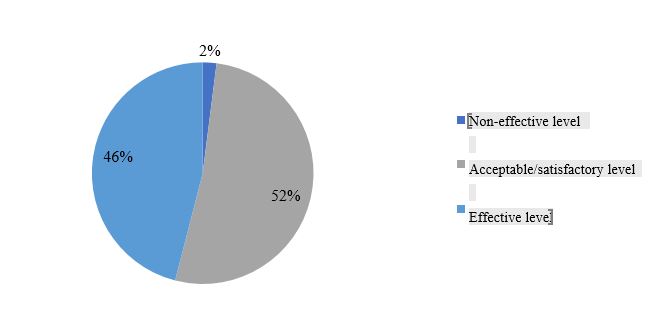
About 2 % of the students are distinguished by their unproductive working, a low emotional background of interaction with information technologies, and dissatisfaction with e-learning as a study mode. 52 % of the students are characterized by a positive attitude to the work, but it is not enough to call e-learning mode as an effective one. Most likely, this is due to the insufficient development of the indicative and operational-technical components of some educational and professional activities, as well as to the self-organization skills applied in doing the activities which are technology-mediated. 46 % of the respondents demonstrate a productive mode of work, good performance, intellectual and creative potential, a high emotional background to use e-learning tools and methods based on them.
Figure
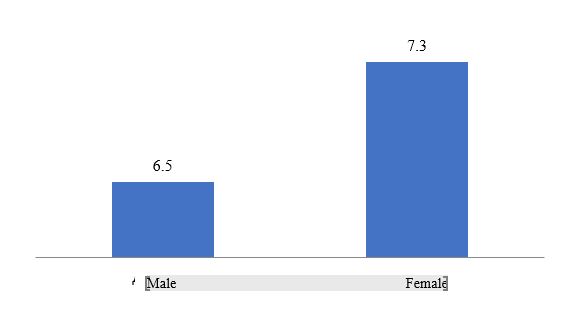
Figure
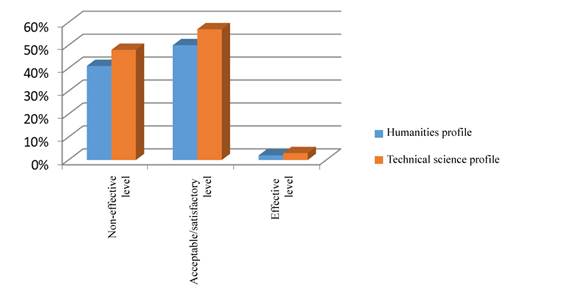
48 % of the technical students and 41 % of the humanities students feel good when interacting with computer technologies. They note productivity at work and a positive attitude to computer-based activities. 57 % of the respondents in the engineering field and 50 % in the humanitarian field experience a satisfactory feeling when working with a computer. This is the average level of productivity. 2 and 3 % of the students, respectively, in engineering and humanitarian programs, experience an unsatisfactory feeling when working with a computer, a low psycho-emotional background of the interaction with a computer and technologies. In general, we see a slight dispersion among the levels.
Mathematical data processing according to the general indicator of the psychological efficiency of the students when interacting with computer technologies was carried out with the Mann-Whitney criterion. This method did not reveal any significant differences in the parameters covering the gender and the students' study profiles. Thus, basically, the student, regardless of the gender and specificity of university training, quite effectively solve the learning tasks with computer programs, and they (students) do not experience as well any dissatisfaction when working with a computer.
Next, we move to the results reflecting the level of students' self-organization. Figure
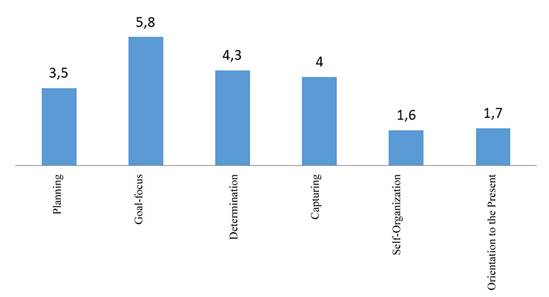
The ratio of values in terms of criteria was distributed as follows: the first position is taken by "Goal-focus" (5.8). Next, there is "Determination" (4.3) and "Capturing" (4), which have very close positions. This is followed by "Planning" (3.5), "Self-Organization" (1.6) and "Orientation to the Present" (1.7).
Mathematical processing with the Friedman Criterion revealed statistically significant differences between the values (χr2 = 568,924; p = 0). In general, the students are characterized by the ability to concentrate on goals and be determined; they have a tendency to be focused on a pre-planned structure of events’ organization in time, either a tendency to make strong-willed efforts to complete an ongoing tasks; the readiness to be involved in daily planning that is guided by certain rules and principles. The comparative analysis towards the efficiency by gender is presented in Figure
The distribution of the criteria values reveals some trends. The criteria such as "Planning", "Determination", "Self-organization", "Orientation to the present" are higher among the male students, whereas, the criteria as "Goal-focus" and "Capturing" are higher among the female ones. The independence in planning is more typical to the male students; they focus on planning details and demonstrate strong-willed efforts in structuring their actions. They use some planning aids and are focus more on the present rather than on the past. The female students are distinguished by their diligence, aspiration to achieve a result in any activities they are involved in. However, the mathematical processing of the results, done within the Mann-Whitney criterion, did not reveal any significant differences within the gender parameter.
Figure
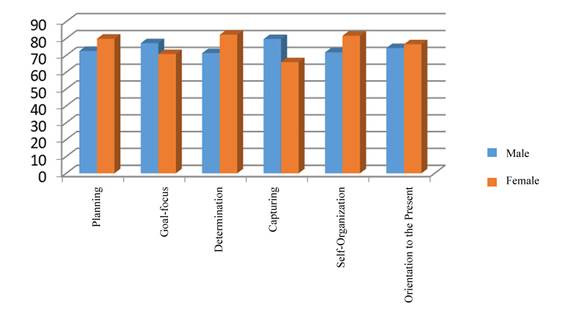
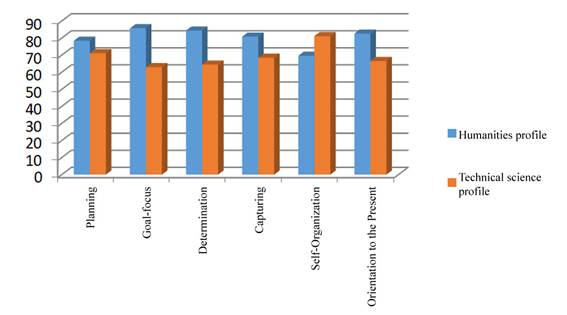
Figure
The psychological efficiency of the interaction with e-learning technologies positively correlates with “Goal-focus” (rs = 0.339 p = 0.00) and “Determination” (rs = 0.331 p = 0.00). The more students show off these qualities, the more effective the educational information interaction is.
The development of the ability to concentrate on goals and a tendency to intensify strong-willed efforts to complete the work started earlier and the ability to rationalize the activity the students are doing will make them more effective in the interaction with electronic learning tools.
Conclusion
Planning on how to use the lifetime, ways of time and resource distribution, and structuring are important components of people's lives in the contemporary world. These factors can also be indicators of their personal efficiency. The organization of the space supporting the virtual educational interaction should involve the characteristics responsible for self-organization skills development. Goal-focus and determination in achieving the goals increase the psychological efficiency when students are interacting with information technologies.
References
- Dvoryatkina, S., Shcherbatykh, S., & Shcherbatykh, L. (2018), Synergy of mathematics, informatics and innovative didactics (on the example of retraining of teachers of mathematics). In 12th Int. Conf. of on Education and New Learning Technologies ICERI2018 (pp. 2503–2509). https://doi.org/10.21125/iceri.2018.1549
- Dvoryatkina, S., Smirnov, E., & Lopukhin, A. (2017). New opportunities of computer assessment of knowledge based on fractal modeling. In Proc. of the 3rd int. conference on higher ed. Advan. (HEAd/17) (pp. 854–864). https://doi.org/10.4995/head17.2017.5445
- Dvoryatkina, S. N., Melnikov, R. A., & Smirnov, E. I. (2017). Technology of synergy manifestation in the research of solution’s stability of differential equations system. Europ. J. of Contemporary Ed., 6(4), 684–699.
- Harris, R. (2003). Psychology of Mass Communications. Prime-Euroznak.
- Mandrikova, E. Ju. (2010). Development of a self-organization questionnaire. Psychol. Diagnost., 2, 87–111.
- Nikolaev, R., & Shabanova, M. (2016). Appliction of computer tools for mistakes’ prevention in exam tasks of optimization investment. In 3rd Int. multidisciplinary sci. conf. on soc. Sci. & arts SCEM. conference proceedings, Book 1, Psychology & Psychiatry, Sociology & Healthcare, Education, vol. 1 (pp. 549–556). https://doi/10.5593/sgemsocial2016B11
- Sanina, E., Artyukhina, M., Frolov, I., & Zhiganova, O. (2018). The theory and technique of interactive training in mathematics at the higher school. In INTED2018 12th Int. Technology, Education and Development Conf (pp. 7946–7950). Valencia, Spain.
- Sungurova, N., Sysoeva, N., Glamazdin, I., & Kryukovskaya, G. (2018). Internet Techlologies as a Means of Establishing Informative Preferences and Motivational attitudes of Natural Sciences Specialties Students. In 10th Int. Conf. on Education and New Learning Technologies (pp. 8898–8907). Palma.
Copyright information

This work is licensed under a Creative Commons Attribution-NonCommercial-NoDerivatives 4.0 International License.
About this article
Publication Date
31 October 2020
Article Doi
eBook ISBN
978-1-80296-091-4
Publisher
European Publisher
Volume
92
Print ISBN (optional)
-
Edition Number
1st Edition
Pages
1-3929
Subjects
Sociolinguistics, linguistics, semantics, discourse analysis, translation, interpretation
Cite this article as:
Sakhno, O., & Pavlovskaya, O. (2020). The Euphemistic Way Of Nomination In The Russian Language. In D. K. Bataev (Ed.), Social and Cultural Transformations in the Context of Modern Globalism» Dedicated to the 80th Anniversary of Turkayev Hassan Vakhitovich, vol 92. European Proceedings of Social and Behavioural Sciences (pp. 2366-2371). European Publisher. https://doi.org/10.15405/epsbs.2020.10.05.312

